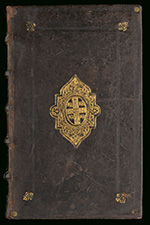Cambridge Bookbindings 1450-1770
This collection illustrates and describes 45 bookbindings made in Cambridge during the handpress period, from the collections of the University Library. They include ordinary, unsophisticated bindings made for scholars or libraries as well as more expensive ones made to please wealthy bibliophiles, to influence patrons, or to bolster the social status of their owners. It is part of a project connected with the 2023 Sandars Lectures, aiming to help everyone who works with books like this to recognise and date Cambridge bindings when they encounter them. For fuller information and a more comprehensive set of illustrations, see Cambridge Bookbinding 1450-1770 by David Pearson (Ann Arbor: the Legacy Press, 2023, https://www.oakknoll.com/pages/books/139144 ).
There are many thousands of books bound in Cambridge during these centuries, now to be found in libraries all over the world (though there is, as might be expected, a concentration in Cambridge libraries). Cambridge, along with Oxford and London, was during the handpress period one of the three major centres of bookbinding and book trade activity; the presence of the University ensured a steady demand for, and traffic in, both new and secondhand books. Many bookbinders therefore spent their careers in Cambridge, and today we can name at least a hundred who were working there between the fifteenth and eighteenth centuries. More remain anonymous in the fragmentary documentary records we have inherited. Bookbinding, like all aspects of early modern book production, was until the early nineteenth century a wholly handcrafted process, and no two bindings will ever be identical. Binders always offered their customers a spectrum of choice around the sturdiness of the structure, and the extent of decoration; the more they paid, the better the end product. Books were not issued by their publishers uniformly bound, in the way we are familiar with today.
Some early Cambridge bindings are recognised and documented, but most are not. Earlier work in this field, like so much bookbinding literature, tends to focus on upmarket, highly decorated work; Cambridge binders did indeed produce some very handsome books during these centuries, along with many more which are less spectacular to behold, but just as much part of the book-historical fabric. At a time when we are increasingly interested in the book as a material object, when we want to better understand where, how and by whom books were used, there is real value in filling out the picture.
If we know that a book was bound in Cambridge, we can guess that it was read and used there, at least initially. If we observe differences in the kinds of bindings commissioned by Cambridge academics or institutions at various points in time, we can ask intellingent questions about the motivations behind parchment wrappers, workaday calfskin, or gilded books which cost more than they needed to in order to be functional. Many books were bound or revisited by Cambridge binders decades, or centuries, after they were printed; by analysing patterns of the repair and rebinding of books, by looking at what was chosen (or not) and how much wear and tear those books have subsequently experienced, we can think about what such evidence can tell us about the perceived values of particular texts. Many Cambridge bindings include fragments of other books, because recycled manuscript or printed waste was extensively used until the end of the seventeenth century; when we can identify Cambridge as the place of origin of those fragments, we learn more about libraries and the circulation of books there. There are therefore many good reasons for honing our skills in recognising early Cambridge bindings.
Dr David Pearson


